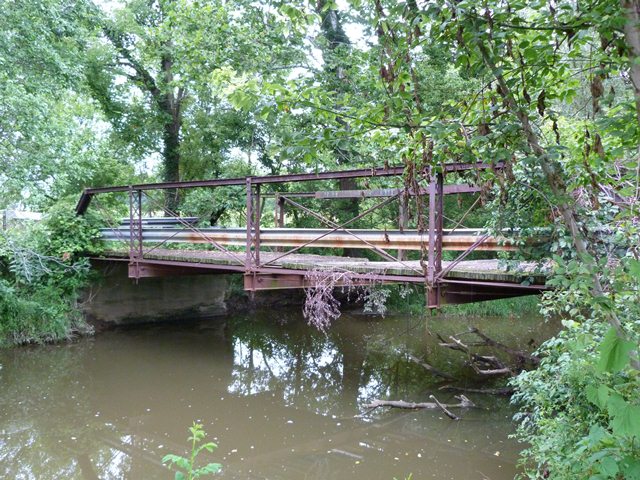We Recommend:
Bach Steel - Experts at historic truss bridge restoration.
Chipps Road Bridge

Primary Photographer(s): Nathan Holth
Bridge Documented: August 11, 2012
Rural: Morrow County, Ohio: United States
By Builder/Contractor: Wrought Iron Bridge Company of Canton, Ohio
1955
50.0 Feet (15.2 Meters)
52.2 Feet (15.9 Meters)
11.2 Feet (3.41 Meters)
1 Main Span(s)
5931134

View Information About HSR Ratings
Bridge Documentation
View Archived National Bridge Inventory Report - Has Additional Details and Evaluation
This bridge is an example of a Wrought Iron Bridge Company pony truss. It displays several of the unique details that the company used on its pony truss, including threaded rod with nut connections for the diagonals at the end posts, where a cast iron connector plate is also found. This bridge is closed to traffic. The north truss is in terrible condition. One diagonal member has been destroyed and cut out, and the top chord is severely sagging. The sagging section of top chord was at some point crudely repaired by welding plate to it.
Despite the condition of the bridge, it should be noted that this bridge could still be restored. It would be particularly feasible to restore it for reuse in a new location for non-motorized traffic, such as on a bicycle trail, rail-trail, etc.
Information and Findings From Ohio's Historic Bridge InventorySetting/Context The bridge is closed to traffic. It is in a rural setting. Physical Description The 1 span, 52'-long, pin-connected Pratt pony truss bridge is a half-hip configuration. It is traditionally composed of built-up compression members and eyebar or rod tension members. It has the cast connecting pieces at the end posts and threaded diagonal rods typical of the Wrought Iron Bridge Co. Integrity Closed in 1995 due to damage from truck. Non-in-kind repairs to upper chords and verticals are evident. Truss is racked. Summary of Significance The ca. 1874 Pratt pony truss is wracked and has a large modern splice at the upper chord, and at least one replacement vertical, a result of impact damage that closed the bridge in 1995. Several, if not all,
members are damaged or warped, significantly impacting the integrity of original design and materials. The design, with its distinctive upper chord panel point connection details, is characteristic of Wrought Iron Bridge Co. (WIBCo)
Pratt pony trusses dating from the mid 1870s to early 1890s. The design is described as "very popular" and having been built widely in an 1881 WIBCo catalogue. Although a very early example of this WIBCo design, there are more
complete in Morrow County and in the state. It is 1 of at least 13 very similar examples. A more complete example, also dating to 1874, is 5930146. The bridge is recommended not eligible due to the loss of integrity and the
existence of more complete examples. Bridge Considered Historic By Survey: No |
![]()
Photo Galleries and Videos: Chipps Road Bridge
Bridge Photo-Documentation
Original / Full Size PhotosA collection of overview and detail photos. This gallery offers photos in the highest available resolution and file size in a touch-friendly popup viewer.
Alternatively, Browse Without Using Viewer
![]()
Bridge Photo-Documentation
Mobile Optimized PhotosA collection of overview and detail photos. This gallery features data-friendly, fast-loading photos in a touch-friendly popup viewer.
Alternatively, Browse Without Using Viewer
![]()
Maps and Links: Chipps Road Bridge
Coordinates (Latitude, Longitude):
Search For Additional Bridge Listings:
Bridgehunter.com: View listed bridges within 0.5 miles (0.8 kilometers) of this bridge.
Bridgehunter.com: View listed bridges within 10 miles (16 kilometers) of this bridge.
Additional Maps:
Google Streetview (If Available)
GeoHack (Additional Links and Coordinates)
Apple Maps (Via DuckDuckGo Search)
Apple Maps (Apple devices only)
Android: Open Location In Your Map or GPS App
Flickr Gallery (Find Nearby Photos)
Wikimedia Commons (Find Nearby Photos)
Directions Via Sygic For Android
Directions Via Sygic For iOS and Android Dolphin Browser
USGS National Map (United States Only)
Historical USGS Topo Maps (United States Only)
Historic Aerials (United States Only)
CalTopo Maps (United States Only)

